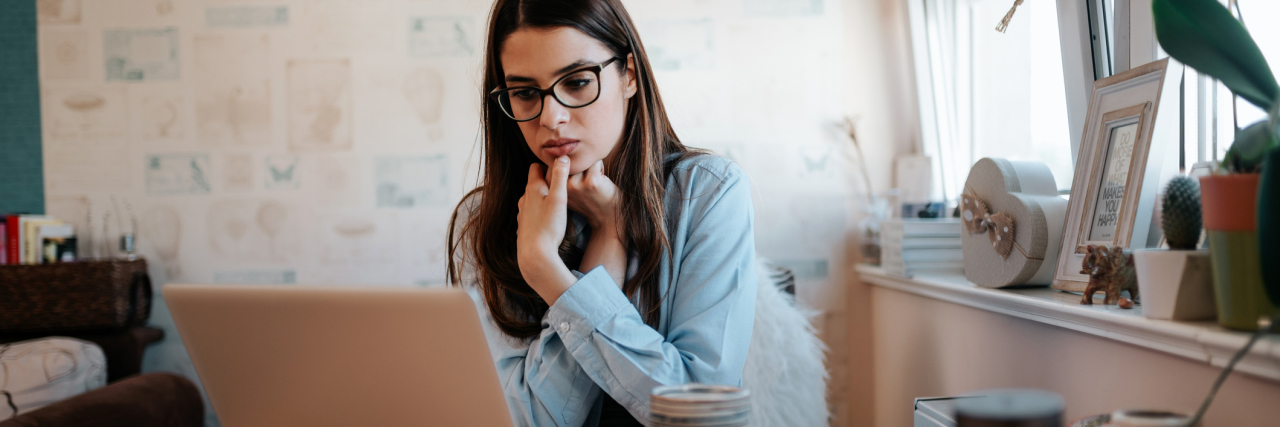What Teletherapy Is Like When You Hate Video Calls
Editor's Note
Join The Mighty’s Coronavirus group to connect with other Mighties living through the pandemic. Read the latest updates, share helpful tips, or give and receive virtual support.
God, I hate being on video. Always have. Even way back in 1980-something when my dad used to tote around his gargantuan camera with the corded microphone attached and try to get me to somehow be adorable and charming, videotaping felt foreign and invasive to me. I didn’t like when the camera was too close, or thinking about how the things I said would exist in perpetuity (yes, these are things I thought about when I was 6). Fortunately, this has never really been a major issue. It’s not like I chose a life where I would have to interact with the world through television or videoconferencing multiple times each week, but here we are in the middle of the coronavirus (COVID-19) pandemic — a new-to humans virus causing respiratory infection that can lead to serious or fatal health complications — and videoconferencing has become routine for so many people.
For me, it’s still painfully awkward and nerve-racking. I’m constantly twirling my hair, touching my face, adjusting my body and checking my microphone to make sure it’s on mute when it should be. I even try to remain extra quiet when my mic is on mute, just in case the internet is messing with me.
I hate the way I look, the way I sound, the angle of a shot that is too high, or too low. We may be over a month into working from home, but this all still feels very new to me.
Work meetings are one thing. I can just about manage to handle the perfunctory exchange of pleasantries, announcements and agenda items in a staff meeting. Video conferencing for other reasons leaves me with sweaty palms and a pounding chest. Virtual happy hour? No thanks. FaceTime dinner with friends? Pass. Zoom family reunion? Holy crap, no. And the newest video challenge I have to contend with… teletherapy. I didn’t sign up for this. I really dislike it. But as I often say in my face-to-face sessions, “it is what it is.”
I’ve struggled with depression and anxiety for nearly as long as I can remember, and I’ve been seeing the same therapist on and off for nearly 12 years now. She knows me so well. I have always felt completely heard and validated under her care. Her office hasn’t changed in all the time I’ve visited. Me on the right side of the couch, near the tissues, a floppy-eared dog sleeping on my left. The bookshelf that sits behind her chair, where I frequently focus my gaze when I’m feeling vulnerable, or uncomfortable. I can stare the spines of various books on trauma-informed care or the little sign that says, “Behind every successful woman is herself.” Under the bookshelf is a cabinet where I mentally unpack and store things I’d like to leave behind until my next session. It’s a very safe place. And now I can’t go there.
I have to do therapy from home, which thankfully, is also a safe place, and I count my blessings I have more than one safe place and person. But home is everything right now. It’s where I sleep. It’s my office. My husband’s office. It’s school for two kids. It’s restaurants and movies and the gym and library. It is not a therapist’s office. I can’t leave my house and drive the 20 minutes to my appointment, taking deep breaths and thinking about where the conversation might go that day. There isn’t any place to unpack the things that are too painful to carry so I can leave them behind for a week until we can tackle them at the next session. There isn’t a car to jump into and allow myself space to process, exhale or cry before I can bring myself back to equilibrium and make my way home. And there isn’t that connection you get to have just by being in the same space as another human who can see your struggle and help you work through it.
Signing into a video conference for therapy feels like signing into a staff meeting. It’s a place to check in, maybe think about some plans for the immediate future. It doesn’t feel like a place to really take stock of struggle or success, or to really even allow myself to feel anything other than the things on the very surface. Anything else seems far too intimate for a video platform. And so, for now, therapy feels very stagnant to me. I don’t feel myself making forward progress. I feel like I’m just treading water. I’m not drowning or fighting a current, so that’s a blessing. But I find myself waiting, floating in one spot and looking forward to when I can get back to swimming.
Struggling with depression or anxiety due to COVID-19? Check out the following articles from our community:
- 6 Tips If You’re Anxious About Being Unable to Go to Therapy Because of COVID-19
- 7 Things to Do If Social Distancing Is Triggering Your Depression
- What to Do If the Coronavirus Health Guidelines Are Triggering Your Anxiety or OCD
- How Can You Tell the Difference Between Anxiety and COVID-19 Symptoms?
- Feeling Calm in the Midst of the Coronavirus Pandemic Might Be a Trauma Response
- What You Should Know About Social Distancing During COVID-19
If you can relate to Miriam, let her know in the comments below.
Getty image by nortonrsx

